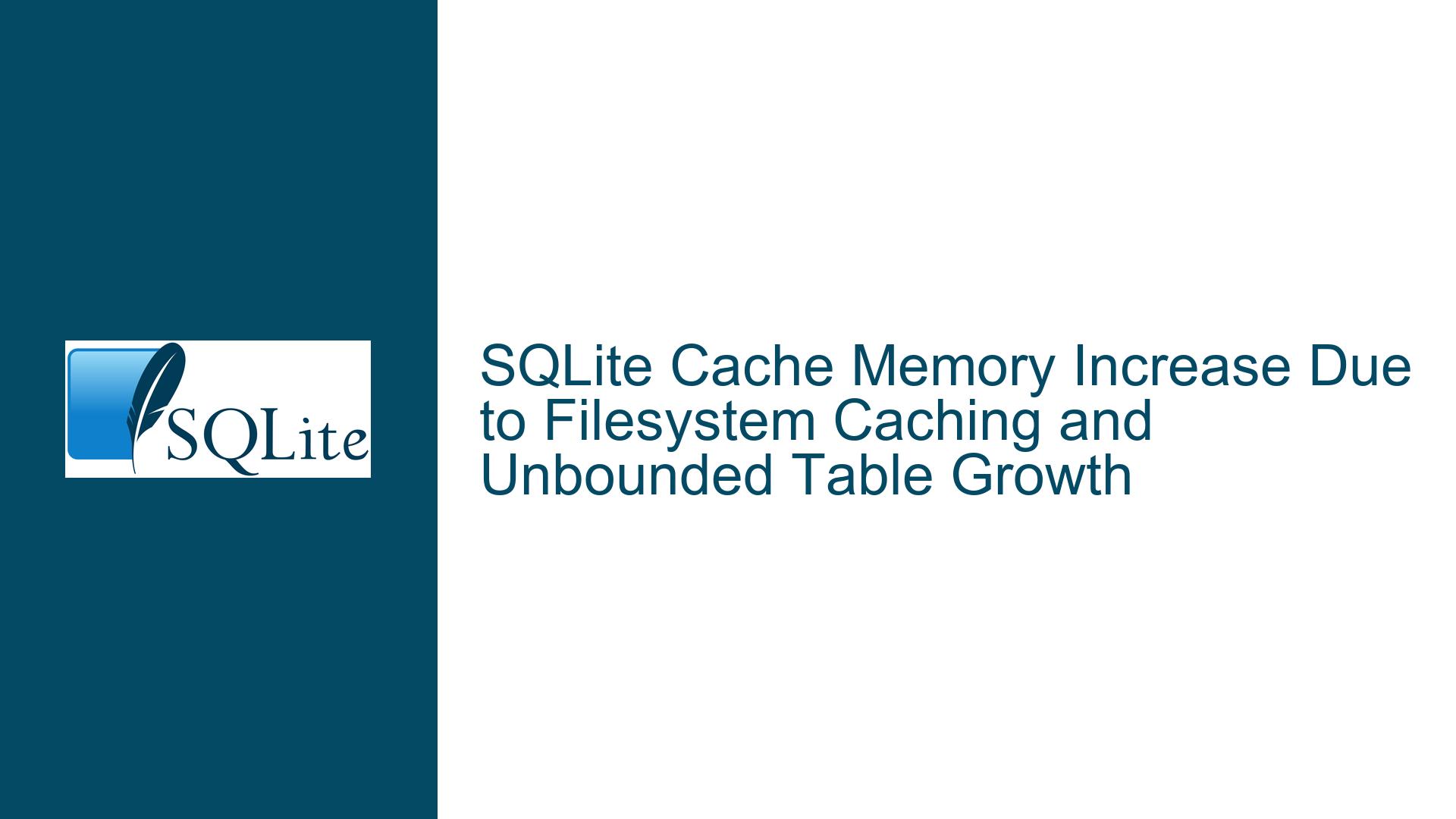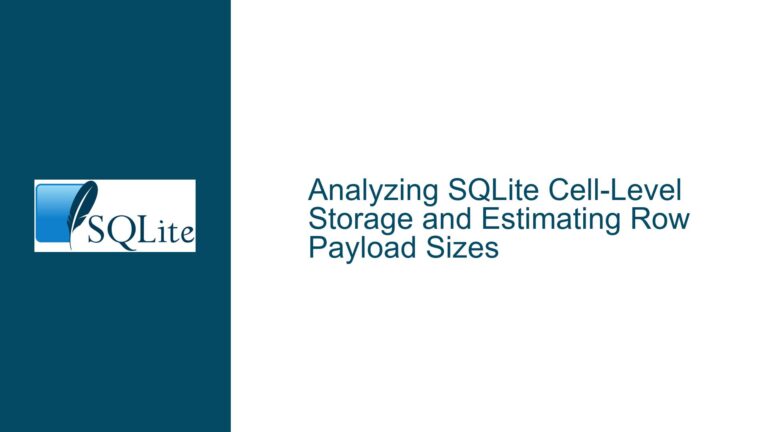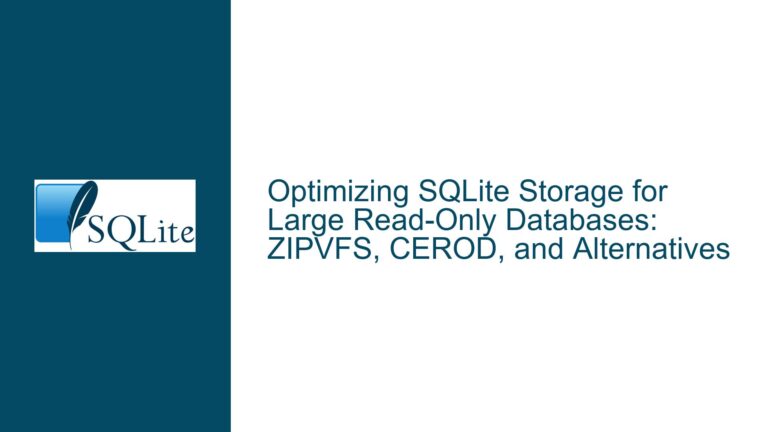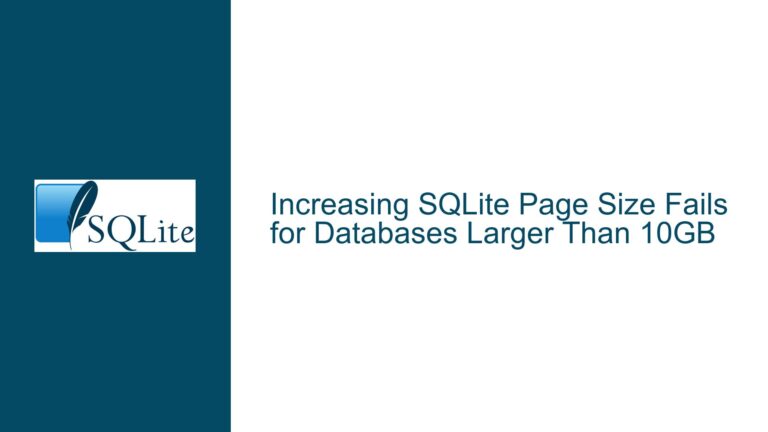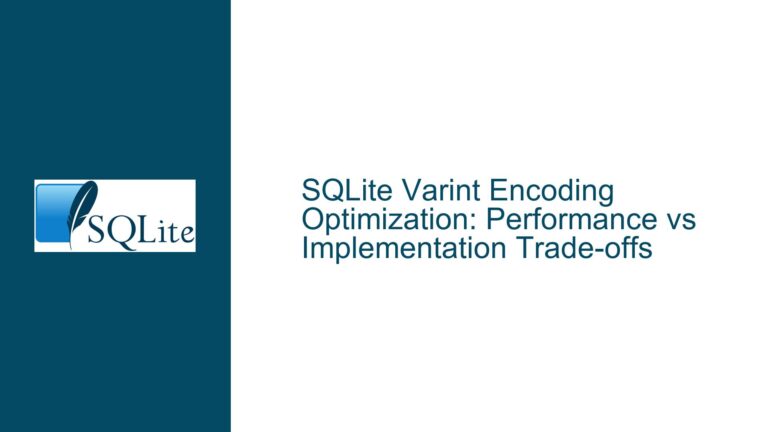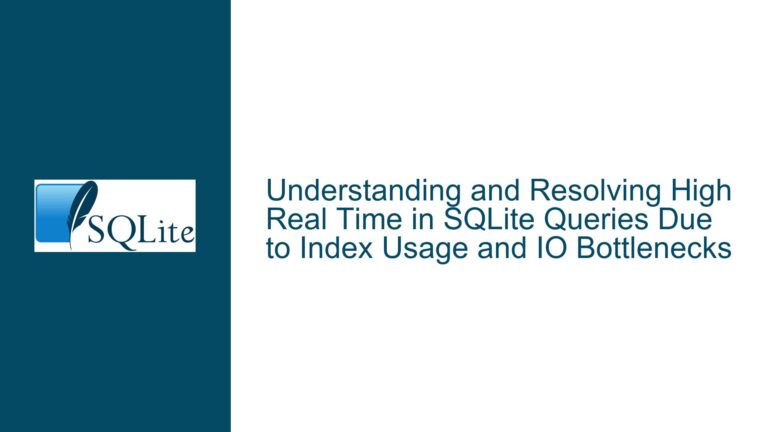SQLite Cache Memory Increase Due to Filesystem Caching and Unbounded Table Growth
SQLite Database File Growth and Filesystem Cache Behavior
When working with SQLite in a Linux environment, it is common to observe an increase in the system’s cache memory usage, particularly when performing frequent write operations such as INSERT statements. This behavior is not inherently a flaw in SQLite but rather a result of how the operating system manages filesystem caching. SQLite interacts with the filesystem to read and write database files, and the Linux kernel caches these filesystem operations to optimize performance. As the database file grows, the kernel allocates more memory to cache the file’s data, leading to an increase in the "cached" memory reported by tools like top.
In the provided scenario, the application continuously inserts rows into a table without any bound, causing the database file to grow indefinitely. Each insertion results in new data being written to the file, which the Linux kernel caches in memory. This caching mechanism is designed to improve performance by reducing the need for repeated disk I/O operations. However, if the database file grows unchecked, the cache memory usage can also grow, potentially leading to resource exhaustion on systems with limited memory.
The issue is exacerbated by the fact that the application runs in an infinite loop, performing insertions without any form of cleanup or archiving. This results in a linear growth of both the database file and the associated filesystem cache. While SQLite itself does not leak memory, the combination of unbounded table growth and filesystem caching can create the appearance of a memory issue.
Interrupted Write Operations and Filesystem Cache Dynamics
The primary cause of the observed cache memory increase lies in the interaction between SQLite’s write operations and the Linux filesystem cache. When SQLite performs an INSERT operation, it writes data to the database file. The Linux kernel caches this data in memory to optimize future read and write operations. This caching behavior is particularly noticeable when the database file grows rapidly, as each new write operation requires additional memory to cache the newly written data.
The sqlite3_exec() function, used in the provided code, executes SQL statements and handles the associated filesystem I/O. Each call to sqlite3_exec() for an INSERT statement results in new data being written to the database file, which the kernel caches. Over time, as the number of insertions increases, the cache memory usage grows proportionally. This behavior is not specific to SQLite; any application performing frequent write operations to a file would exhibit similar cache memory growth.
Another factor contributing to the issue is the lack of memory management constraints in the application. SQLite provides mechanisms to limit its internal memory usage, such as the SQLITE_CONFIG_HEAP and SQLITE_CONFIG_MMAP_SIZE configuration options. However, these settings do not affect the filesystem cache, which is managed by the operating system. Without explicit constraints on the database file size or periodic cleanup of old data, the cache memory usage will continue to grow.
Additionally, the use of usleep(10 * 1000) in the loop introduces a delay between insertions, which can lead to fragmented writes. This fragmentation increases the likelihood of the kernel caching multiple small writes, further contributing to cache memory growth. While this delay may be intended to simulate real-world usage, it exacerbates the issue by spreading out the write operations over time.
Mitigating Cache Memory Growth Through SQLite Configuration and Filesystem Tuning
To address the issue of cache memory growth, several strategies can be employed, ranging from SQLite configuration adjustments to filesystem tuning and application-level changes. These solutions aim to balance performance with resource usage, ensuring that the system remains responsive even under heavy load.
SQLite Configuration Adjustments
Limiting SQLite’s Internal Cache Size: SQLite provides configuration options to control its internal cache size. The
PRAGMA cache_sizedirective can be used to limit the number of database pages held in memory. For example, settingPRAGMA cache_size = 1000;limits the cache to 1,000 pages, reducing SQLite’s memory footprint. This setting does not affect the filesystem cache but can help mitigate overall memory usage.Using WAL Mode: Enabling Write-Ahead Logging (WAL) mode with
PRAGMA journal_mode = WAL;can improve write performance and reduce contention between readers and writers. WAL mode also reduces the need for frequent writes to the main database file, which can help limit filesystem cache growth.Configuring Memory-Mapped I/O: SQLite supports memory-mapped I/O, which allows the database file to be mapped directly into the application’s address space. This can reduce the overhead of filesystem caching by allowing SQLite to manage its own memory usage. The
PRAGMA mmap_sizedirective can be used to control the size of the memory-mapped region.
Filesystem Tuning
Adjusting Filesystem Cache Limits: Linux provides mechanisms to control the size of the filesystem cache. The
sysctlcommand can be used to adjust kernel parameters such asvm.dirty_ratioandvm.dirty_background_ratio, which control the percentage of system memory that can be used for dirty (unwritten) pages. Reducing these values can limit the growth of the filesystem cache.Using
drop_cachesto Free Cache Memory: Thedrop_cachesmechanism can be used to manually free filesystem cache memory. Writing a value to/proc/sys/vm/drop_cachesinstructs the kernel to drop clean caches, freeing up memory. For example, runningecho 3 > /proc/sys/vm/drop_cachesas root drops both pagecache and slab caches. This approach is useful for testing but is not a long-term solution.
Application-Level Changes
Implementing Data Archiving and Cleanup: To prevent unbounded table growth, the application should implement a mechanism for archiving or deleting old data. For example, a background process could periodically remove rows older than a certain threshold or move them to an archive table. This reduces the size of the active database file, limiting cache memory usage.
Batching Insert Operations: Instead of performing individual insertions with delays, the application can batch multiple insertions into a single transaction. This reduces the number of write operations and allows the kernel to cache larger blocks of data more efficiently. For example, the application could collect 100 rows and insert them in a single transaction.
Monitoring and Alerts: Implementing monitoring and alerting mechanisms can help detect and address cache memory growth before it becomes a problem. Tools like
vmstat,sar, and custom scripts can track memory usage and trigger alerts when thresholds are exceeded.
Example Implementation
The following example demonstrates how to apply some of these strategies in the provided code:
#include <sqlite3.h>
#include <stdio.h>
#include <unistd.h>
int main() {
int cnt = 0;
sqlite3 *db;
char *errMsg = NULL;
// Open the database
sqlite3_open_v2("test.db", &db, SQLITE_OPEN_READWRITE | SQLITE_OPEN_CREATE, NULL);
// Enable WAL mode
sqlite3_exec(db, "PRAGMA journal_mode = WAL;", NULL, NULL, &errMsg);
// Set a cache size limit
sqlite3_exec(db, "PRAGMA cache_size = 1000;", NULL, NULL, &errMsg);
// Create the table
sqlite3_exec(db, "CREATE TABLE IF NOT EXISTS test_tbl (STRING TEXT, NUMBER INTEGER);", NULL, NULL, &errMsg);
// Batch insertions
for (cnt = 0;; cnt++) {
if (cnt % 100 == 0) {
// Start a new transaction every 100 insertions
sqlite3_exec(db, "BEGIN TRANSACTION;", NULL, NULL, &errMsg);
}
char buf[20];
sprintf(buf, "text%d", cnt);
char sql[100];
sprintf(sql, "INSERT INTO test_tbl (STRING, NUMBER) VALUES ('%s', %d);", buf, cnt);
int ret = sqlite3_exec(db, sql, NULL, NULL, &errMsg);
if (errMsg) {
sqlite3_free(errMsg);
errMsg = NULL;
}
if (cnt % 100 == 99) {
// Commit the transaction every 100 insertions
sqlite3_exec(db, "COMMIT;", NULL, NULL, &errMsg);
}
usleep(10 * 1000);
}
sqlite3_close(db);
printf("End!!!\n");
return 0;
}
This example demonstrates the use of WAL mode, cache size limits, and batched insertions to mitigate cache memory growth. By combining these techniques with filesystem tuning and application-level changes, the issue can be effectively managed.
In conclusion, the observed cache memory increase is a result of the interaction between SQLite’s write operations and the Linux filesystem cache. By understanding and addressing the underlying causes, it is possible to mitigate the issue and ensure optimal performance and resource usage.
